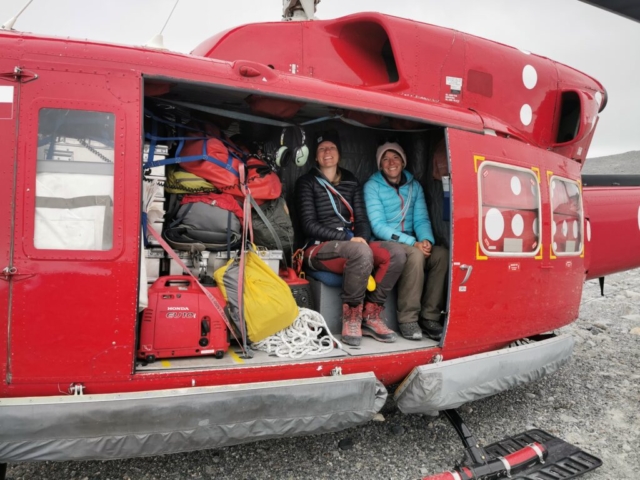
Fishing instruments from a helicopter
Installing instruments on Greenlands fastest glacier is a great challenge, and recovering them after weeks or months an art. From our field work campaigns in summer 2022 we came back with tons of data – and some impressive images.
Sermeq Kujalleq in Kangia (Jakobshavn Isbrae) flows at speeds up to 40 meters per day, which leads to an intensely crevassed surface. Calving of cubic-kilometer-sized icebergs strongly affects glacier flow, but how exactly fast flow, calving and floating ice influence each other is not well-understood, and is exactly what our project aims to investigate.
Essential: good eyes, perfect team work, and a very skilled pilot
Instrumenting such a fast-moving glacier is very challenging, and recovering the instruments after a few weeks or months an art. Finding and fishing from the hovering helicopter for the instruments from the open side door requires very good eyes, perfect team work, and a very skilled pilot. We performed exactly this kind of work during the three COEBELI field campaigns in May, July and September 2022. We successfully installed 25 stations on the extremely crevassed glacier surface, each registering seismic waves and glacier motion at very high accuracy.
Fishing a sensor box from the hovering helicopter with a small boat anchor requires strong nerves.
Video: Ana Nap
Spectacular calving events
During a two-week field camp in summer we additionally used long-range drones to map the glacier more than 10 times at a resolution of 30 cm. With a terrestrial radar interferometer we registered the glacier motion every two minutes, and can measure changes in ice motion at very high rate, either driven by melt water, internal processes, or by large calving events. We were lucky to observe a series of spectacular calving events during the July field camp. The breaking and rotation huge icebergs was captured simultaneously by all our measurement instruments and time-lapse cameras. One of these events is shown in the movie below (in double speed).
A large-scale calving event where ice submerged 800 meters deep races to the surface and collapses spectacularly. Video: Ana Nap
Numerical models to understand the complex processes
Currently, we are analyzing this unique and extensive data set, and we have already detected exciting and unexpected speed variations and seismic events. The PhD candidates Ana and Adrien and the Post-Docs Andrea and Hugo are now busy processing these data, and implementing numerical models to understand the many intricately coupled processes leading to the fast flow of this glacier.
#GIUZ #ImageOfTheWeek
A cathedral of ice, more than 200 meters high, is raised and immediately destroyed
| The COEBELI project investigates the dynamics of Greenlands fastest glacier and is a collaboration between GIUZ/UZH, WSL and EPFL. |
Martin Lüthi, Ana Nap, Andrea Walter, Adrien Wehrlé, Hugo Rousseau, Guillaume Jouvet




